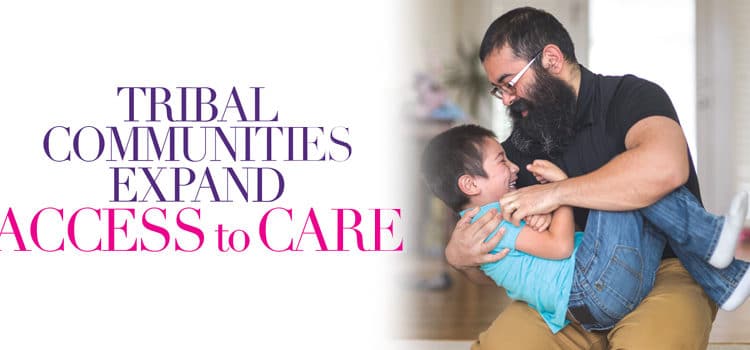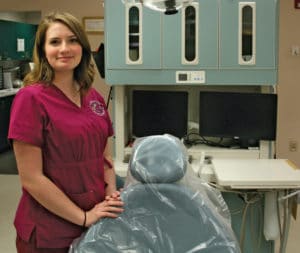 FATCAMERA/E+/GETTYIMAGESPLUS
FATCAMERA/E+/GETTYIMAGESPLUS
Tribal Communities Expand Access to Care
Native communities in Oregon and Washington are using dental health aide therapists to help improve oral health access and outcomes.
Tribal communities are struggling under the weight of devastating oral health disparities. The prevalence of dental caries in American Indian/Alaska Native (AI/AN) children ages 2 to 5 is nearly three times the United States average.1 More than 70% of AI/AN children ages 2 to 5 have a history of tooth decay compared with 23% of white children.1
AI/AN adults also experience twice the prevalence of untreated caries as the general US population—more than any other racial/ethnic group.2 AI/AN adults are also more likely to have severe periodontal diseases, more missing teeth, and more likely to report poor oral health than the general US population.2 These outcomes are a result of the many barriers to professional oral health care experienced by AI/AN populations, including: chronic underfunding of the Indian Health Service, shortage of dentists coupled with high turnover rates, geographic isolation, lack of AI/AN providers, and historical trauma precipitated by oppressive policies and practices over the past 200 years.3,4
There is no silver bullet for improving these oral health outcomes, and, in fact, the numbers are trending slowly in the right direction, as tribal solutions to this crisis continue to be employed. One of these proven strategies is the growing and diversifying of the oral health care workforce through the use of dental health aide therapists (DHATs), or dental therapists. Tribal health providers in Oregon are piloting this strategy as part of the Oregon Health Authority’s Dental Pilot Project Program. The goal of this program is to “encourage the development of innovative practices in oral health care delivery systems with a focus on providing care to populations that evidence-based studies have shown have the highest disease rates and the least access to dental care.”5
HISTORY OF DENTAL THERAPIST USE IN NATIVE COMMUNITIES
The use of dental therapists is not new. Alaska Natives have been on the forefront of building a system of village-based health care providers through the Community Health Aide Program (CHAP), adding the training and employment of DHATs in 2005.
Under the general supervision of a dentist, DHATs can practice in remote settings where there is need for additional providers, expand capacity of urban clinics, and work in close collaboration with dental hygienists and dentists to develop programs that bring dental care outside of the operatory. Their scope6 of practice was designed to meet the needs of communities that have experienced a lack of access to care and is limited to about 50 procedures that can provide relief from pain, basic treatment of disease, and preventive education and services. In the 10+ years they have been practicing in Alaska, DHATs have expanded care to more than 45,000 Alaska Natives, and improved oral health outcomes for the communities in which DHATs are working. A study published in August by the University of Washington School of Dentistry7 found that over 10 years, villages in the Yukon Delta in Alaska with DHATs (compared to villages without DHATs) experienced the following outcomes:
- 284% decrease in first four front teeth extractions for children younger than 3
- 26% decrease in extractions for adults
- 60% increase in access to preventive care for children
- 75% increase in access to preventive care for adults
- 44% decrease in the need to put children under general anesthesia for full mouth rehabilitations
Besides the overall goal of increasing access and improving outcomes, the CHAP model of recruiting by and for the community results in newly trained providers going back to their homes to deliver care—and staying there. Tribal leaders consider the role of social determinants in promoting health and health equity and are interested in utilizing programs that strengthen their communities and create education and employment opportunities for tribal members. Seeing a provider that looks like you, speaks your language, and knows your culture is important in building trust among those who have experienced historical trauma, and for inspiring a future workforce of AI/AN providers.
The overwhelming success of the Alaska program inspired other tribal communities to explore how to use these midlevel practitioners in their own health programs. In 2016, the Swinomish Indian Tribal Community8 in Washington imported this system of care for its dental clinic, using its sovereign authority to license an experienced DHAT from Alaska. A year later, Washington tribes secured legislation authorizing DHATs to provide services throughout the state on tribal lands.
In Oregon, the state legislature created a pilot project in 20115 that allowed the Oregon Health Authority to approve dental pilot projects. The projects are intended to:
- Teach new skills to existing categories of dental personnel
- Develop new categories of dental personnel
- Accelerate the training of existing categories of dental personnel
- Teach new oral health care roles to previously untrained persons
Dental therapy was an excellent match with these workforce goals, so in 2016, the Northwest Portland Area Indian Health Board, in collaboration with the Confederated Tribes of Coos, Lower Umpqua, and Siuslaw Indians (CTCLUSI), Coquille Indian Tribe, and Native American Rehabilitation Association of the Northwest, approved the Tribal Dental Therapy Project as the first pilot project in the state.9

In preparation for implementation of the pilot, CTCLUSI recruited a student, Naomi Petrie, in 2015 to attend the 2-year DHAT education program in Alaska. Once this pioneering student had her education underway, the project worked to secure approval of the pilot, recruited students for 2016 and 2017, and created and began implementing an extensive evaluation and monitoring plan required by the state as part of the pilot. Measureable outcomes of the project were identified and, at the conclusion of the pilot, these will show how the DHATs are impacting quality and quantity of care, access, and cost.
The work over the past 2 years has led the project to its utilization phase. Petrie graduated in June 2017 and started providing services at a Coos Bay Dental Clinic a month later (Figure 1). Four other students are in school, graduating in 2018 and 2019. An experienced Alaska DHAT, who is a member of Oregon’s Cow Creek Band of Umpqua Tribe, just joined the dental team at the Native American Rehabilitation Association Dental Clinic. This Urban Indian Program provides a full spectrum of health services to the large AI/AN community in the Portland area.
The Tribal Dental Therapy Project looks forward to providing the state with data to help make permanent decisions about how to address oral health disparities in tribal communities and beyond, as the current delivery system of dental care is failing underserved communities across the state.10 But the immediate benefits of this pilot are already happening. Young AI/AN students are being educated in an accessible program for a living-wage profession. A new DHAT has returned to her community as a provider and as a role model for others in her community. And most important, dental teams are expanding quality care, right now, to those who need it most.
REFERENCES
- Phipps KR, Ricks, TL. The oral health of American Indian and Alaska Native children aged 1-5 years: results of the 2014 IHS Oral Health Survey. Indian Health Service Data Brief. Rockville, Maryland: Indian Health Service; 2015.
- Phipps KR, Ricks TL. The oral health of American Indian and Alaska Native adult dental patients: results of the 2015 IHS oral health survey. Indian Health Service Data Brief. Rockville, Maryland: Indian Health Service; 2016.
- Gee GC, Ford CL. Structural racism and health inequities: old issues, new directions. Du Bois Rev. 2011;8:115–132.
- Sarche M, Spicer P. Poverty and health disparities for American Indian and Alaska Native children: current knowledge and future prospects. Ann N Y Acad Sci. 2008;1136:126–136.
- Oregon Health Authority, Public Health Division, Prevention and Wellness, Oral Health. Available at: public.health.oregon.gov/PreventionWellness/OralHealth/DentalPilotProjects. Accessed September 18, 2017.
- Northwest Portland Area Indian Health Board, Native Dental Therapy Initiative. Available at: npaihb.org/download/authoring_project/native_dental_therapy_initiative/DHAT-PROCEDURES.pdf. Accessed Sept 18, 2017
- Chi D, Lenaker D, Manci L, Dunbar M, BAbb M. Dental utilization for communities served by dental therapists in Alaska’s Yukon Kuskokwim Delta: findings from an observational quantitative study, 2017. Available at: faculty.washington.edu/dchi/files/DHATFinalReport.pdf. Accessed September 18, 2017
- Cladoosby BS. Indian Country leads national movement to knock down barriers to oral health equity. Am J Public Health. 2017;107(S1):S81–S84.
- Oregon Health Authority, Public Health Division, Prevention and Wellness. Oral Health. Available at:oregon.gov/oha/PH/PREVENTIONWELLNESS/ORALHEALTH/DENTALPILOTPROJECTS/Pages/projects.aspx. Accessed September 18, 2017.
- Pew Charitable Trusts. Oregonians Face Challenges Getting Dental Care. Available at: pewtrusts.org/~/media/assets/2015/11/or-dental-infographic_v3_print.pdf?la=en. Accessed September 18, 2017.
From Perspectives on the Midlevel Practitioner, a supplement to Dimensions of Dental Hygiene. October 2017;4(10):43-45.

